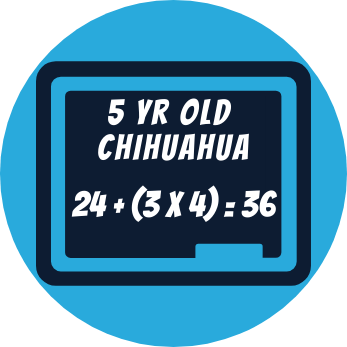If you have a dog, you’ve probably heard the calculation that 1 dog year equals 7 human years, right? Well, not quite. While this idea of the 1:7 ratio has been prevalent for a surprisingly long time (since the 1950s!), it turns out the reality is not so cut-and-dried.
How your dog ages depend quite a lot on their size and breed. This actually makes a lot of sense when you think about it. Most pet parents know that smaller dogs tend to live longer than larger dogs. For example, a Great Dane’s life expectancy is about 7-10 years, while a Miniature Poodle can live as long as 18 years. So it makes sense that a 6-year-old Great Dane would be considered much older in people years than a 6-year-old Miniature Poodle.
So if the 1:7 rule isn’t correct, how exactly do you figure out how old your dog is in human years? Here’s what you need to know about how (and why) to calculate your dog’s age in human years.
Your Dog’s First Year
For their first year of life, the same rule applies for all types of dogs: On average, a dog will age to the level of a 15-year-old human during their first year. This might seem like a lot, but a puppy is doing a ton of physical and mental growth in that formative first year. By their first birthday, your pup should understand basic commands, be sexually mature physically, and believe themselves to be independent, thinking of the world as theirs to explore. Sounds like a teenager, right?
 Calculating Dog to Human Years
Calculating Dog to Human Years
No matter what, you can figure that by the time your dog is 2 years old, you’re living with the equivalent of a 24-year-old human. After age 2, however, size and breed come into play. Here’s the right way to calculate your dog’s age:
- Small dogs age 4 human years per year after age 2
- Medium dogs age 5 human years per year after age 2
- Large dogs age 6 human years per year after age 2
So basically, if your dog is over 2, you start with the number 24 and add as many years over 2 as they are, then multiply that by the number above. So for example, if you have a
- 5-year-old Chihuahua, they’re about 36 in human years (24 + (3 x 4) = 36)
- 5-year-old Basset Hound would be 39 in human years (24 + (3 x 5) = 39)
- 5-year-old German Shepherd would be 42 in human years (24 + (3 x 6) = 42)
The Importance of Calculating Your Dog’s Age in Human Years
Of course, learning your dog’s age in human years is just plain interesting! But there’s also a practical reason to do it. Just like humans, as dogs get into their golden years, they typically are more prone to health issues and need more health care. But sometimes it can be difficult for pet parents to spot signs of aging in their beloved dog.
For example, imagine your Chihuahua is still as active, energetic, and crazy as ever. They seem fine, right? No need to take them to the veterinarian. But what if you found out they’re 60 in human years? Suddenly it seems like a good idea to take them for a checkup.
Taking your dog to the veterinarian for regular checkups is one of the best things you can do to catch health issues before they become serious (and seriously expensive). Knowing your dog’s age in human years is just the push many pet parents need to make this happen. In addition, it can also make you think about starting to add supplements to their diets, or changing their food to a “senior” version.
Estimating Age
What if you don’t know your dog’s birthday? If you’ve adopted a pup, first of all, good for you! Second, you probably want to know their age. They hold the key in their mouths, specifically, in their teeth. While a veterinarian can tell you hold old your new furry friend is based on their teeth as signs of aging, here are some simple guidelines for how you can tell at home:
- 1 year old: If your dog has a full set of shiny white teeth, they’re probably about a year old. Puppies get their permanent teeth by the time they’re around 7 months, and it takes about at least another 5 or so months before they start yellowing
- 1 to 2 years old: If you notice slight yellowing on the back teeth, your dog is likely 1 to 2 years of age.
- 3 to 5 years old: Tartar starts to build up around 3 to 5 years of age, and gets worse over time. The more tartar buildup, the older your dog is.
- Senior years: If your dog’s teeth look severely worn or are even missing, there’s a good chance they can be considered a senior dog.
Others signs of aging include graying hair around the muzzle, face, head, and body, loss of muscle definition, stiffness in their limbs, and cloudy eyes, which all are indicators of senior status.

You now have everything you need to know to calculate your furry friend’s age in human years! Keep in mind that while these rules are more accurate than the 1 dog year per 7 human years ratio, they are still guidelines. The quality of your dog’s years matters just as much as, or perhaps even more than, the quantity.
Their “age” depends a great deal on their diet, exercise, and general physical, mental, and emotional condition. So helping your dog stay active, keeping them at an ideal weight, feeding them high-quality food, and making sure they have plenty of mental stimulation and of course, lots of love, will help them stay happy, healthy, and young at heart.



 Calculating Dog to Human Years
Calculating Dog to Human Years







